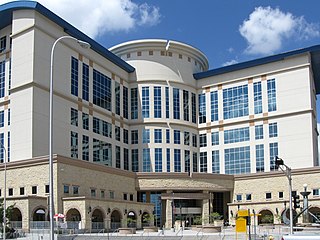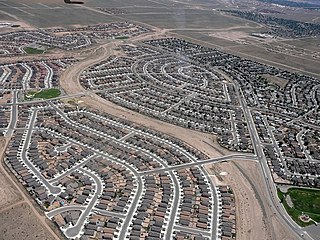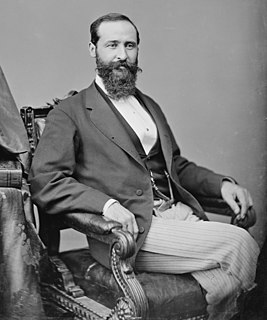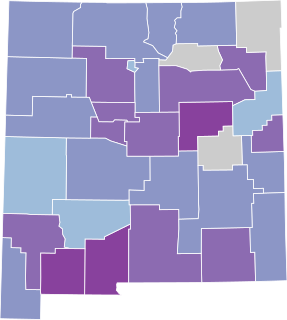
Albuquerque, abbreviated as ABQ, is the most populous city in the U.S. state of New Mexico. Its nicknames, The Duke City and Burque, both reference its 1706 founding by Nuevo México governor Francisco Cuervo y Valdés as La Villa de Alburquerque. Named in honor of the Viceroy of New Spain, the 10th Duke of Alburquerque, the city was an outpost on El Camino Real linking Mexico City to the northernmost territories of New Spain. The 2020 census found the population of the city to be 564,559, making Albuquerque the 32nd-most populous city in the United States and the fourth-largest in the Southwest. It is the principal city of the Albuquerque metropolitan area, which had 916,528 residents as of July 2020.

Santa Fe County is located in the U.S. state of New Mexico. As of the 2010 census, the population was 144,170, making it New Mexico's third-most populous county, after Bernalillo County and Doña Ana County. Its county seat is Santa Fe, the state capital.

Sandoval County is located in the U.S. state of New Mexico. As of the 2010 census, the population was 131,561, making it the fourth-most populous county in New Mexico. The county seat is Bernalillo.

Bernalillo County is the most populous county in the U.S. state of New Mexico. As of the 2010 census, the population was 662,564. The county seat, Albuquerque, is the most populous city in New Mexico.

The New Mexico Rail Runner Express is a commuter rail system serving the metropolitan areas of Albuquerque and Santa Fe, New Mexico. It is administered by the New Mexico Department of Transportation (NMDOT) and the Rio Metro Regional Transit District, a regional transportation agency, while Herzog Transit Services currently holds the contract for the operation and maintenance of the line & equipment. Phase I of the system, operating on an existing right-of-way from Belen to Bernalillo that NMDOT purchased from BNSF Railway, opened in July 2006. Phase II, the extension of the line to Santa Fe, opened in December 2008. Daily ridership, as of February 2019, was 2,200 trips per day.

Rio Rancho is the largest and only city in Sandoval County, part of the expansive Albuquerque metropolitan area, in the U.S. state of New Mexico. A small portion of the city extends into northern Bernalillo County.

Sandoval County/US 550 is a station on the New Mexico Rail Runner Express commuter rail line, located in Bernalillo, New Mexico, United States.

Henry Connelly was Governor of the New Mexico Territory during the American Civil War. He was appointed by President Lincoln and served from September 4, 1861 until July 6, 1866. During his term, the territory broke into two, and then three parts due to the Civil War and administrative problems.

The Albuquerque–Santa Fe–Las Vegas combined statistical area is made up of eight counties in north central New Mexico. The combined statistical area consists of the Albuquerque and Santa Fe metropolitan statistical areas, and the Las Vegas, Los Alamos, and Española micropolitan statistical areas. The 2013 delineations included the Grants micropolitan statistical area, but it was removed in the 2018 revisions. As of the 2010 census, the CSA had a population of 1,146,049. The population of the CSA is 1,178,664 as of the July 1, 2018 Census Bureau estimate. Roughly 56% of New Mexico's residents live in this area. Prior to the 2013 redefintions, the CSA consisted only of the Santa Fe metropolitan statistical area and the Española micropolitan statistical area. The total land area of the Albuquerque–Santa Fe–Las Vegas combined statistical area in the 2013 definition is 26,421 sq. mi.

The Albuquerque Metropolitan Statistical Area is a metropolitan area in central New Mexico centered on the city of Albuquerque comprising four counties: Bernalillo, Sandoval, Torrance, and Valencia. As of the 2010 United States Census, the MSA had a population of 887,077. The population is estimated to be 923,630 as of July 1, 2020, making Greater Albuquerque the 61st-largest MSA in the nation. The Albuquerque MSA forms a part of the larger Albuquerque–Santa Fe–Las Vegas combined statistical area with a 2020 estimated population of 1,165,181, ranked 49th-largest in the country.

José Francisco Chaves was a nineteenth-century military leader, politician, lawyer and rancher from the New Mexico Territory.
Same-sex marriage became legally recognized statewide in the U.S. state of New Mexico through a ruling by the New Mexico Supreme Court on December 19, 2013, requiring all county clerks to issue marriage licenses to qualified couples seeking marriage regardless of gender. Until then, same-sex couples could only obtain marriage licenses in certain counties of the state. Eight of the 33 counties, covering 58% of the state's population, had begun issuing marriage licenses to same-sex couples in August and September 2013. New Mexico's marriage statute is not specific as to gender. It is the only state lacking a state statute or constitutional provision explicitly addressing same-sex marriage. Lacking a state law or judicial ruling concerning same-sex marriage prior to December 19, 2013, policy for the issuance of marriage licenses to same-sex couples was determined at the county level at the discretion of local issuing authorities i.e., some counties recognized same-sex marriage and issued marriage licenses to same-sex couples, while others did not. Despite the ruling by the New Mexico Supreme Court allowing same-sex marriages in the state, some of New Mexico's Native American tribes continue to prohibit same-sex marriages within their jurisdictions and do not recognize same-sex marriages performed elsewhere.

The Rio Grande Trail is a proposed long distance trail along the Rio Grande in the U.S. state of New Mexico. The river extends over 1,800 total miles, some 700 miles (1,100 km) of which pass through the heart of New Mexico. It is the state's primary drainage feature and most valuable natural and cultural resource. The river and its bosque provide a wide variety of recreation, including hunting and fishing, birdwatching, river rafting, hiking, biking, and horseback riding. The river also flows through or beside numerous spectacular and geologically interesting landforms, the result of extensive volcanism and erosion of the valley within the Rio Grande Rift. Although some trail advocates would like to see the trail extended the full distance through New Mexico, from the Colorado border to the United States–Mexico border, the portion proposed for initial development extends 300 miles (480 km), from Bernalillo south to Las Cruces.

Under the provisions of the Kearny Code as promulgated in 1846, the first legislature of New Mexico commenced its session on December 6, 1847. The Council consisted of seven members, with Antonio Sandoval, of Bernalillo County, as president, and the House of twenty-one members, with W.Z. Angney as speaker.

The Jemez River is a tributary of the Rio Grande in eastern Sandoval County, New Mexico, United States.

The 1996 United States presidential election in New Mexico took place on November 5, 1996. All fifty states and the District of Columbia, were part of the 1996 United States presidential election. State voters chose five electors to the Electoral College, which selected the president and vice president.
State Road 313 (NM 313) is a 17.091-mile-long (27.505 km) state highway in the US state of New Mexico. NM 313's southern terminus is at NM 556 in Albuquerque, and the northern terminus is at the end of state maintenance in San Felipe Pueblo. Much of the route is an old routing of U.S. Route 85.

The COVID-19 pandemic was confirmed to have reached the U.S. state of New Mexico on March 11, 2020. On December 23, 2020, the New Mexico Department of Health reported 1,174 new COVID-19 cases and 40 deaths, bringing the cumulative statewide totals to 133,242 cases and 2,243 deaths since the start of the pandemic. During the last quarter of 2020, COVID-19 hospitalizations in New Mexico increased, reaching a peak of 947 hospitalizations on December 3.

Barton is a census-designated place (CDP) in Bernalillo and Santa Fe counties, New Mexico, United States. It was first listed as a CDP prior to the 2020 census.

















